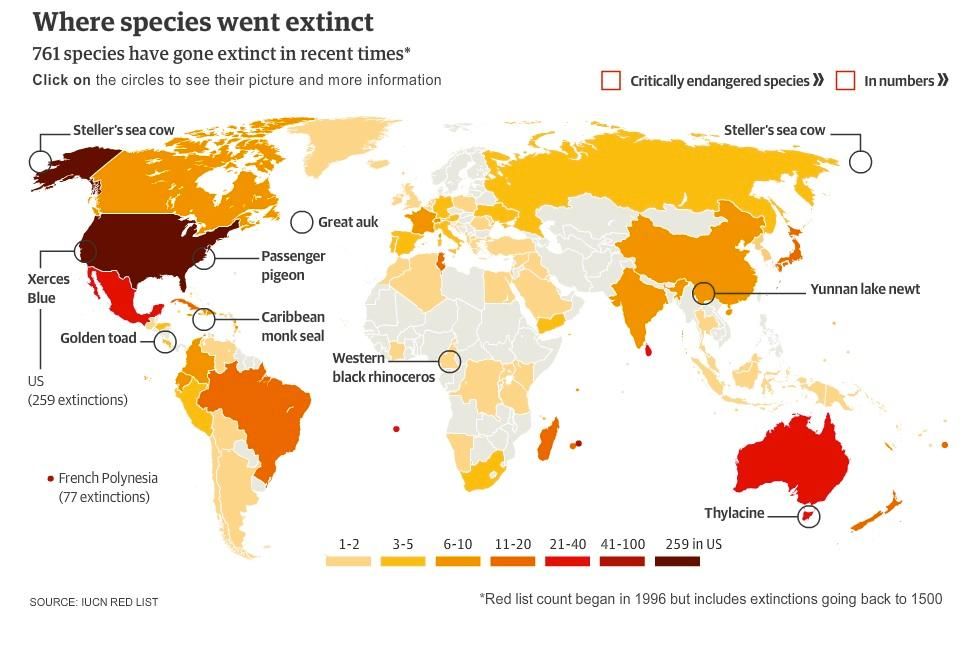Extinction Rates Are Biased And Much Worse Than You Thought
The IUCN’s Red List of endangered species looks bad, but the reality is probably much, much worse
/https://tf-cmsv2-smithsonianmag-media.s3.amazonaws.com/filer/20120903105006passenger-pigeon.jpg)
Human activity—mostly habitat destruction and overhunting—has obliterated nearly 900 species over the past 500 years. Around 17,000 plants and animals are listed today on the International Union for the Conservation of Nature (IUCN) Red List of endangered species. According to the IUCN, one in eight birds, one in four mammals, one in five invertebrates, one in three amphibians and half of all turtles face extinction.
The Guardian produced this guilt-inducing map (see the interactive version on their website) showing how the world’s countries fare when it comes to extinction counts:

For U.S. citizens, this looks particularly bad, while those in Vietnam, Kazakistan and Paraguay come off as innocent protectors of local wildlife. However, this map is inherently biased. These are only documented extinctions, after all. While the U.S. is undoubtedly skilled at bulldozing wetlands to build shopping malls and shooting passenger pigeons into extinction just for fun, we are also exceptionally good at book-keeping. “It is widely suspected that IUCN accounts of species vulnerability are biased toward the better-studied taxonomic groups of the western world,” scientists dryly write in the journal Conservation Biology.
In other words, the West is doing a poor job of saving species, but the rest of the planet likely is, too. Here, the Guardian provides a map of extinct (red) versus critically endangered (yellow) species by regions:

Now, things are starting to even out a bit. Species at imminent risk of extinction tend to cluster in the tropics—South America, Southeast Asia and Sub-Saharan Africa—where high biodiversity is often coupled with deforestation and overhunting.
Unfortunately, however, this map still shows only a very biased slice of the pie. Research tends to focus on the big, the cuddly and the beautiful. Plenty of research is done on polar bears and tigers, but how about dung beetles and fungi, mollusks and mites? In addition to the geographic bias, this species bias also skews the data. An editorial piece from the nonprofit Bat Conservation International elaborates:
The IUCN red list has a substantial geographic bias toward North American species.
Far from reflecting reality, the red list reflects our ignorance regarding the status of most species. We simply have more knowledge about the status of bats in North America than we do for most other parts of the world.
In fact, our ignorance is so extreme that we are not even certain how accurate the IUCN list is for many North American species. We simply do not have the data to determine whether they are stable, increasing or decreasing, and at what rates. Given this lack of information and the fact that most bats investigated are declining, the IUCN red list gives an inaccurate and minimal assessment of the current crisis.
The IUCN is also quick to point out its own shortcomings:
- The number of documented extinctions (844 species since 1500 AD) grossly underrepresents the number of extinctions that have taken place in historic times, due to very incomplete and uneven sampling, both geographically and taxonomically.
- An additional 208 species could already be Extinct, but further information is required to confirm this.
- Data from the IUCN Red List indicate a current extinction rate that is at least two, and probably three, orders of magnitude higher than the background rate typical over the planet’s geological history.
- Very little is known about marine and freshwater extinctions, but preliminary evidence from North America indicates a very high level of extinctions in freshwater habitats.
- Although information is still very limited, there is growing evidence that marine species are less resilient to extinction in the face of threats than was once thought.
- Although the island species have experienced the greatest number of extinctions in historic times, continental extinctions are becoming more frequent, and account for almost 50% of the extinctions confirmed over the last 20 years.
The values shown on those already dismal maps should likely be three times higher than what’s reported, and regardless of whether we know about it, creatures are blinking out all over the planet, all of the time.
More from Smithsonian.com:
In Vietnam, Rhino Horn is the Drug of Choice at Both Parties and Hospitals
One in Five Lizard Species Could be Extinct by 2080
/https://tf-cmsv2-smithsonianmag-media.s3.amazonaws.com/accounts/headshot/Rachel-Nuwer-240.jpg)
/https://tf-cmsv2-smithsonianmag-media.s3.amazonaws.com/accounts/headshot/Rachel-Nuwer-240.jpg)